The succulent plant Gymnocalycium is part of the Cactaceae family. According to data taken from various sources, this genus unites from 50 to 80 species, and most of them are widely cultivated at home. The name "hymnocalycium" is derived from 2 Greek words, which translate as "naked" and "calyx", this is due to the fact that all representatives of this genus have a flower tube not pubescent. In the wild, such a plant can be found in certain regions of Bolivia, Paraguay, Argentina, Uruguay and Southern Brazil, and it prefers to grow in the mountains among stones at an altitude of up to 1,000 meters above sea level, and even on flat places in the grass.
The German scientist L. Pfeiffer in 1844 was the first to describe a plant belonging to this genus. To date, more than 100 species names of such a plant can be found in the literature, and more and more new ones appear every year. But most of the described plants are not separate species, but only forms of those hymnocalycium that are already described in the classification of names. In the thirties of the twentieth century, all species of this plant were divided into 5 groups according to the characteristic features of their seeds. To date, there are already 6 such groups.
Content
- 1 Brief description of cultivation
- 2 Features of the hymnocalycium
- 3 Gymnocalycium care at home
- 4 Diseases and pests
- 5 Types of hymnocalycium with photos and names
- 5.1 Gymnocalycium naked (Gymnocalycium denudatum)
- 5.2 Gymnocalycium anisitsii
- 5.3 Gymnocalycium mihanovichii (Gymnocalycium mihanovichii)
- 5.4 Japanese Gymnocalycium, or Friedrich's Gymnocalycium
- 5.5 Gymnocalycium saglionis, or Gymnocalycium saglionis
- 5.6 Gymnocalycium baldianum
- 5.7 Gymnocalycium leptanthum
- 5.8 Gymnocalycium tiny (Gymnocalycium parvulum)
- 5.9 Gymnocalycium quehlianum
- 5.10 Gymnocalycium humpback (Gymnocalycium gibbosum)
Brief description of cultivation
- Bloom... Typically starts in May and ends in November.
- Illumination... Gymnocalycium needs a lot of bright light all year round, but in the summer it should be diffused.
- Temperature regime... In the warm season, the plant is suitable for the usual room temperature, and in the winter period - from 12 to 15 degrees.
- Watering... Usually sparse, but may be moderate during the growing season.
- Air humidity... It grows normally at the same level of air humidity that is typical for residential premises.However, on hot days in the evening, it is recommended to moisten the bush from a spray bottle.
- Fertilizer... Fertilizer is applied to the soil mixture from April to September. Feeding is carried out 1 time in 4 weeks, a mineral complex fertilizer with a reduced nitrogen content is used for this, and ½ part of the dosage from that indicated on the package is used.
- Dormant period... It starts in late autumn and ends in spring.
- Transfer... It is carried out in early spring, but only when necessary. While the bush is young, it is transplanted annually, and older plants are subjected to this procedure 1 time in 2 years or even less often.
- Reproduction... Children and the seed method. If you are growing a chlorophyll-free species, then grafting must be used to reproduce it.
- Diseases... Root rot.
- Pests... Mealybugs and spider mites.
Features of the hymnocalycium
The stem of the hymnocalycium cactus has the shape of a ball, but it is flattened. The stem can be brown, greenish-gray, greenish-brown or gray. The stem height is almost half the diameter, which varies from 40 to 150 mm. On the surface of the stem, there are 10–32 vertical ribs, on which there are many areoles with bundles of needles, the length of which is 1.3–3.8 cm. In the middle of each areola there are 3–5 straight and long spines, and around them there are radial needles. which are shorter. Flowering is observed from May to November, and bell-shaped flowers are formed on the upper part of the stem, they reach 20–70 mm in diameter, their lanceolate petals are arranged in several rows, and on the surface of the closed calyces there is no pubescence or needles. The flowers can be colored crimson, cream, red or yellow. On the surface of the ovoid fruit, there are scales, its length is about 40 mm, and it can be colored purple, green or red.
Thanks to the work of breeders, chlorophyll-free cultivars were born, the stem of which has a yellow or red color. They are cultivated by grafting on an ordinary green cactus. The Japanese Eiji Watanabe has grown the very first hybrid of such a plant with a red stem.
Gymnocalycium care at home
Indoor hymnocalycium is distinguished by its undemanding care, so even a beginner can cope with its cultivation. In order for the cactus to be as effective as possible, it is necessary to create conditions for it that will be very similar to natural conditions (in its habitats).
Illumination
Such a plant needs bright sunlight all year round. But in summer, on hot days in the afternoon, it must be protected from direct sunlight.
Temperature regime
In the spring and summer, the cactus grows well at room temperature, typical for residential premises. However, in winter, when the plant has a dormant period, it is rearranged to a cooler place (from 12 to 15 degrees), while the light should be bright enough (not the same as in summer, but the plant should have enough of it). Make sure that the room is not too cold, the bush will be able to withstand a temperature drop of up to 8 degrees, but only for a short time.
Watering
Moisten the potted substrate only during the growing season. The abundance of watering for hymnocalycium can vary from scant to moderate. By the onset of the autumn period, watering should be reduced to very scarce, and in winter, the cactus is watered only when the soil mixture in the pot is completely dry. As a rule, an adult bush is watered only 1-3 times during the winter.
You can water the hymnocalycium with tap water, but it must be filtered or well defended and mixed with a small amount of lemon juice. Also pay attention to the water temperature, which should be close to room temperature.It is necessary to assert or filter the water in order to remove lime from it, to which the plant reacts extremely negatively.
Air humidity
A cactus can grow normally at any level of humidity. However, after a sultry day in the evening, it is recommended to moisten it with water from a sprayer. Also, in the warm season, you can arrange a shower for him to remove accumulated dust and dirt from him.
Top dressing
During the growing season, hymnocalycium must be fed. This procedure is carried out once every 30 days, using a complex mineral fertilizer with a low nitrogen content. In the autumn-winter period, the culture does not need additional feeding. Please note that half of the dosage recommended by the manufacturer is used for feeding.
Gymnocalycium transplant
It is not necessary to transplant hymnocalycium too often. This procedure is carried out only after its root system becomes too crowded in the pot, and it begins to look out of the drainage holes. Each subsequent planting container should be only 20 mm larger than the old one. Transplantation of adult bushes is carried out in early spring with a frequency of 1 time in 2 or 3 years. Remove the bush from the container and remove the old soil mixture from its root system; all dead areas are also cut out. Rinse the roots well in hot water, and then leave for two days to dry. After that, the bush is planted in a new container, at the bottom of which a drainage layer is made, do not forget to fill all the voids with a new soil mixture suitable for succulents. The substrate can be bought ready-made in a specialized store or you can cook it yourself, for this you need to combine peat, sand, expanded clay and charcoal. This cactus grows well in a soil mixture consisting of peat, sand, charcoal, turf and leafy soil (2: 3: 1: 2: 3). An acidic substrate is not suitable for growing hymnocalycium; it must be slightly alkaline or neutral. The transplanted bush is not watered for 7 days.
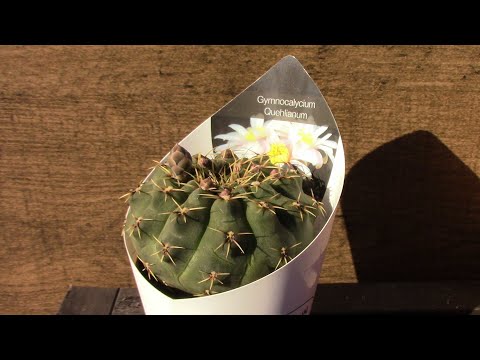

Watch this video on YouTube
Bloom
Typically, a cactus blooms between May and November. If optimal conditions for growth are created for the plant, then it will bloom regularly. It is because of this that such a succulent is very popular with flower growers.
Reproduction of hymnocalycium
To reproduce this cactus use kids and seed... Chlorophyll-free varieties are propagated only by grafting. If the species of hymnocalycium forms children, then there will be no problems with its reproduction. They are separated from the parent bush and left in the open air for 1-2 days to dry. Then they are planted in a moist mixture of peat and sand. As a rule, children quickly grow their own roots. After the planted babies take root, they are provided with the same care as the adult cacti.
But in most species of this genus, children are not formed, so they are propagated by seed. But even those species in which children are formed are much more reliable to propagate by seeds. For sowing seeds, a soil mixture is used the same as for planting an adult plant, but the fractions should be smaller. The substrate must be disinfected, for this it is placed in a heated oven. Only after it has cooled down is it put in cups and spilled with water. It is impossible to deeply bury the seed material in the soil mixture. Crops should be in a well-lit place, while the air temperature should be about 20 degrees. Make sure that the soil mixture is slightly damp all the time, use a spray bottle for watering.


Watch this video on YouTube
If you want to propagate hymnocalycium by grafting, then for this you should take an absolutely healthy scion and stock.During vaccination, you need to make the same sections on them, for this they use a very sharp disinfected instrument. The stock should be attached to the scion, while the conducting bundles should be tried to combine as best as possible. Fix them with tape or elastic band for seven or eight days.
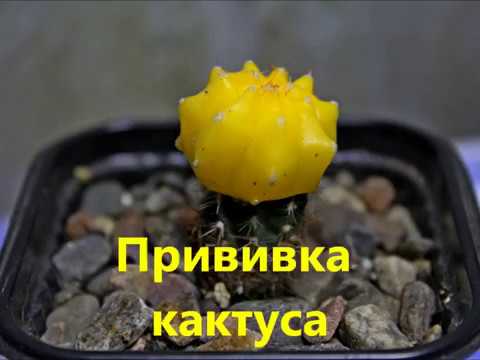

Watch this video on YouTube
Diseases and pests
Diseases
Gymnocalycium can suffer from root rot. It occurs due to improper care, namely, due to the use of excessive nutrient substrate or due to too frequent or very abundant watering. As a rule, rot does not appear on the stem, but it can completely destroy the root system of the bush. You can understand that a cactus is sick by the fact that it begins to grow more slowly and stops blooming. If you notice signs of rot, then dig up the plant, cut out all rotten roots to healthy tissue. Then the root system should be treated with wood ash, crushed charcoal or a fungicidal solution. After that, leave the cactus outdoors for a while to dry well. Then it is placed on the surface of the soil mixture for rooting. In order to prevent root rot from spreading to the stem, the soil mixture in the pot is covered with a layer of expanded clay.
Pests
In some cases, such a dangerous pest as a spider mite settles on the hymnocalycium. This pest very often settles on all succulents and cacti, and it settles where the air is dry. Most often, pests settle on young bushes, as a result, rusty dry specks form on the surface of the stem. If you are growing a small number of cacti, then each of them will need to be washed with slightly hot water, and then the stems are wiped with a cotton swab dipped in a solution of ethyl alcohol. However, if you have a lot of cacti, then it will be easier to spray them with a solution of an acaricidal preparation, for example: Fitoverm, Aktellik, Aktara, etc.
A pest such as a mealybug can settle on the root system of the hymnocalycium. If all worms live underground, then their presence can be noticed by the following signs: lack of flowering, as well as very slow growth. Dig out the bush, free its roots from the substrate and examine them. If you notice mealybugs on the surface of the roots, then immerse them for a quarter of an hour in slightly hot water, its temperature should be such that the hand can hardly withstand it. If you found the worms only on the root system, then to get rid of them, this hot bath is quite enough. However, if pests are present on the cactus stem, then rinse it with hot water as well. Instead of such a bath, the plant can be treated with an insecticidal solution.
Types of hymnocalycium with photos and names
Gymnocalycium naked (Gymnocalycium denudatum)
In this species, the dark green stem is very flattened, and in diameter it reaches about 100 mm. The stem has 5–8 mild ribs with almost no tubercles. Such a plant does not have central needles, but in each areola, which are located over the entire surface of the stem, 5 radial spines are formed in it. In the areoles, located in the lower part of the bush, 8 thorns are formed. The needles, twisting and tightly pressed to the surface of the plant, are part of the spider-like bundles. The spines are painted in a grayish-brown hue, and they reach up to 10 mm in length. Large flowers in this species are usually white. Less common specimens with pinkish flowers.
Gymnocalycium anisitsii
This is a fairly popular cactus in culture. Its stem lengthens as it grows and branches at the base. The height of the stem can be up to 100 mm, and in diameter it can reach about 80 mm. As a rule, the bush has 11 ribs, which are divided into sharp tubercles.Each areola grows from 5 to 7 curved and thin radial needles, the length of which can vary from 10 to 60 millimeters. White beautiful flowers reach about 40 mm in diameter.
Gymnocalycium mihanovichii (Gymnocalycium mihanovichii)
This variety of this genus is the most popular among flower growers. The height of the flattened stem most often does not exceed 50 mm. The surface of the raised ribs is covered with brown horizontal stripes. Slightly curved, silvery needles stick out in different directions. During the flowering period, in the upper part of the bush, pink-greenish or crimson flowers of a wide-bell-shaped shape are formed. It is very easy to care for such a cactus, while it has a spectacular appearance. It was this plant that was used by breeders to create hybrids of purple-brown, yellow and red colors.
Japanese Gymnocalycium, or Friedrich's Gymnocalycium
This variety appeared due to mutation, and breeders from Japan stimulated and strengthened it. Experts used mutating specimens for crossing, as a result of which yellow, burgundy, red and orange cacti were obtained, which also differ in that they do not contain chlorophyll. Such hymnocalycium cannot grow on its own, which is why they need grafting on a green stock. The stem of this plant has the shape of a ball, and in diameter it reaches about 100 mm. 3 ribs are formed on the stem, the edges of which are wavy and sharp. The needles of this cactus are curved and have a brown color. Flowers can be colored lilac or pink.
Gymnocalycium saglionis, or Gymnocalycium saglionis
The stem of such a plant is painted in a pale gray color and it does not form children. It is relatively large, in diameter it can reach 0.3 m. The number of ribs directly depends on the size of the bush and can reach 32 pieces. Curved needles have a lilac-gray color, while in one nest they grow from 10 to 15 pieces, and in length they can reach about 40 mm. Not very large flowers can be pink or white.
Gymnocalycium baldianum
The greenish-gray stem has a flat-shaped shape and reaches a height of 40–100 mm, and about 90 mm in diameter. It can have up to eleven ribs, while at first the tubercles on them are very weakly expressed, but over time they appear more distinctly. From each tubercle, up to seven radial needles grow, painted in an ash-gray or gray-pinkish tint. During flowering, many flowers appear, reaching a diameter of 30-50 mm, they are painted in pink, dark red, white or orange, as well as in all possible intermediate shades.
Gymnocalycium leptanthum
The stem of this cactus is flattened, and in diameter it can reach about 70 mm. On its surface, no more than 8 ribs are formed, which are not very high, and rounded tubercles are located on them. Seven radial needles grow from these tubercles, which are pressed to the surface of the stem. The diameter of the white-colored flowers is about 65 mm, the petals at the base are pale red. On a tall tube, smooth, rounded scales are clearly visible.
Gymnocalycium tiny (Gymnocalycium parvulum)
The greenish-brown stem is ball-shaped and has 13 ribs. On the surface of the ribs, there are high large areoles, each of which is formed by 5–7 radial needles, which are pressed to the stem. Some of the needles can be curved. The color of the flowers is white.
Gymnocalycium quehlianum
The flat-shaped stem reaches about 100 mm in diameter, and it is painted in a green-bluish tint. There are about 10 ribs on the bush, and it may seem that they have grown together, and this is due to the large number of tubercles, which are very densely located.There is pubescence on the areoles, and from each of them five radial needles of an ivory shade grow, and their base is red. Also, in plants that are part of this species, the thorns can be colored in white, brownish-red and yellow. The flowers of this plant are very showy. They reach a height of 60 mm, and they are painted white, and their throat is red.
Gymnocalycium humpback (Gymnocalycium gibbosum)
The stem of this species has the shape of a ball, while it can be painted in a greenish blue or dull green shade. As it grows, the shape of the stem changes to a cylindrical one, and it can reach up to half a meter in height and up to 0.2 meters in diameter. About 15 ribs are formed on the stem, and transverse grooves divide them into segments. On the surface of the areoles, a gray pubescence flaunts. From each areola, one central needle grows, which is slightly curved, its base is red, there are also up to 10 radial spines of the same color, their length is from 10 to 20 mm. The shape of the creamy flowers is funnel-shaped, and in length they reach from 60 to 70 mm. This species has a variety of nigrum: the color of the spines is black, and the stem is green-black.
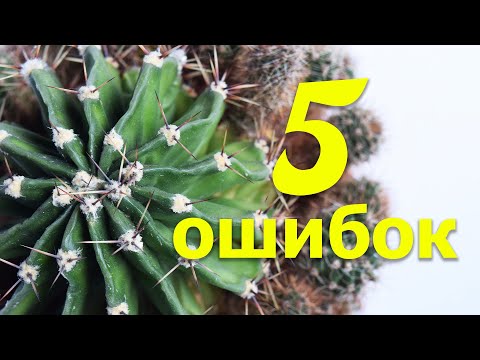

Watch this video on YouTube

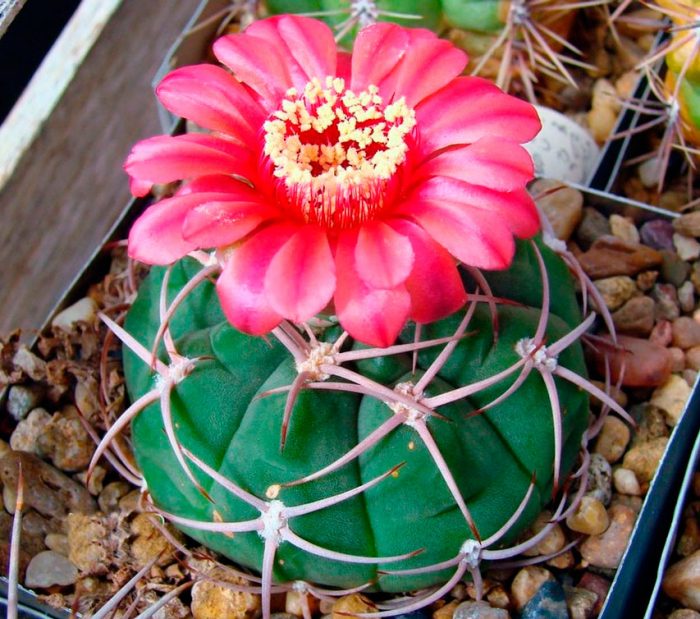
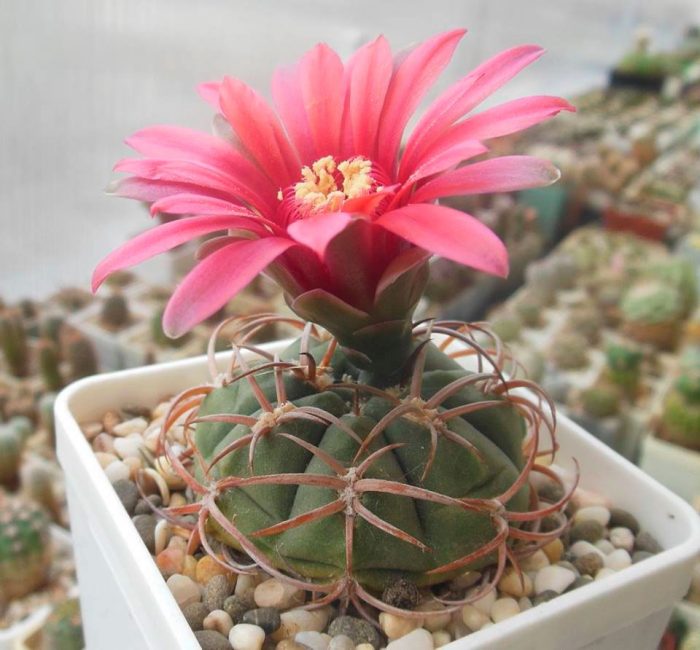
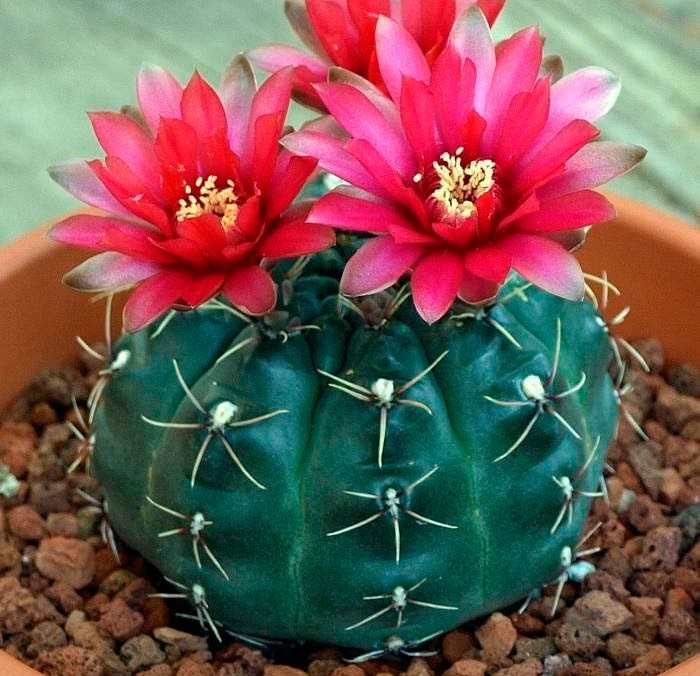
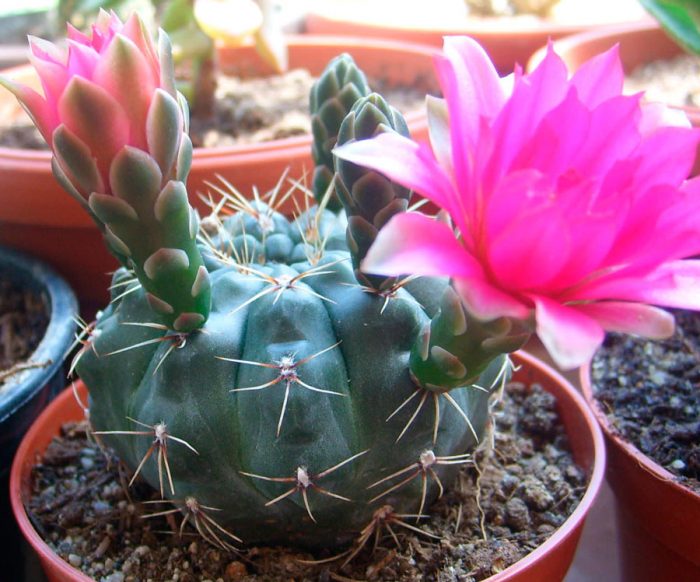
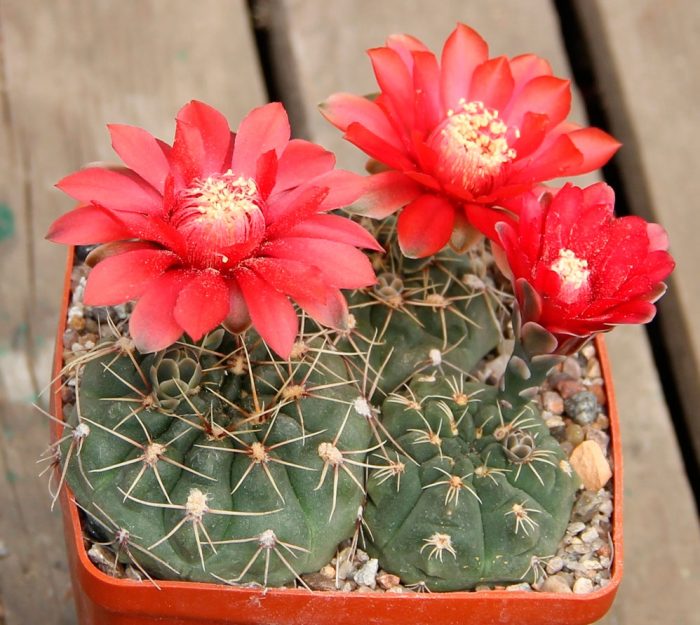
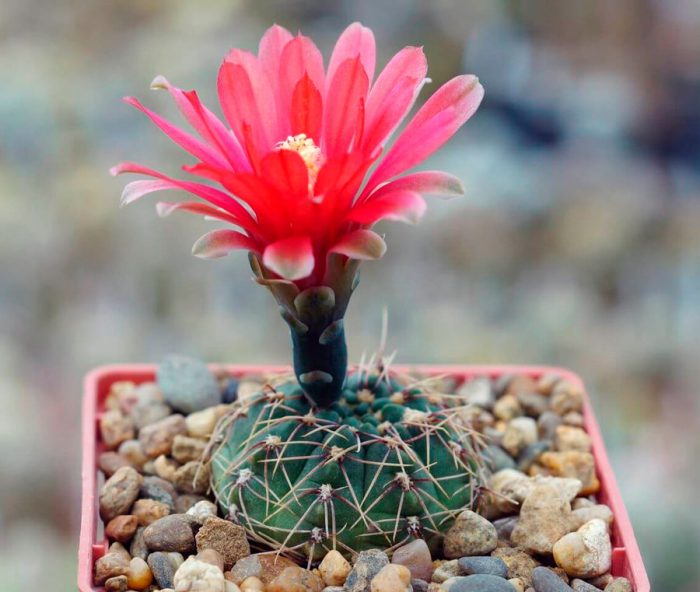
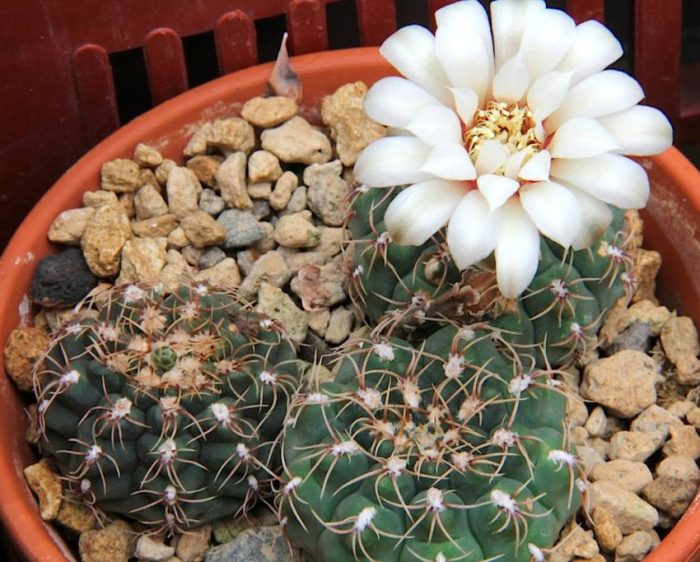
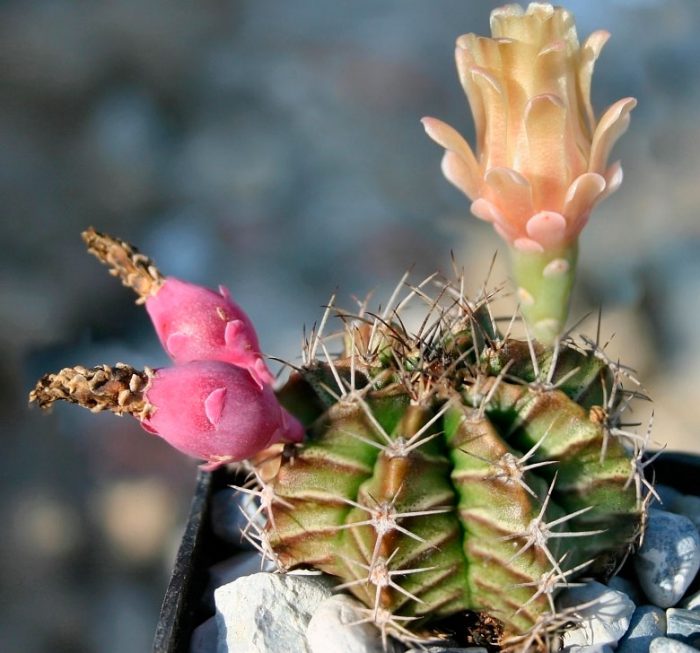
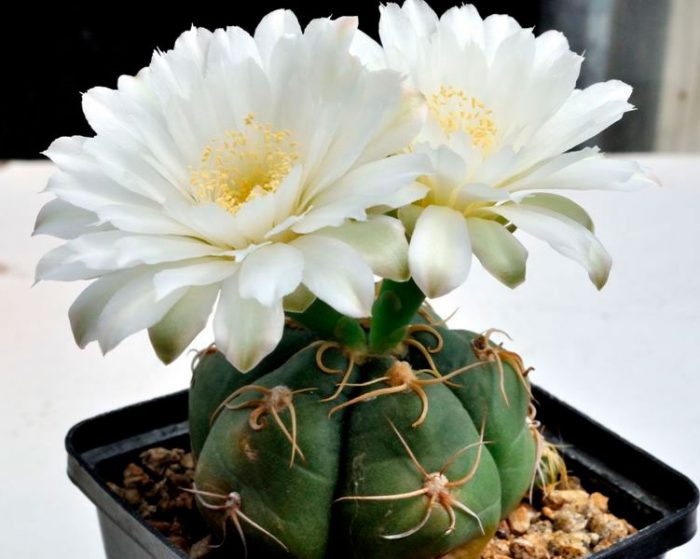
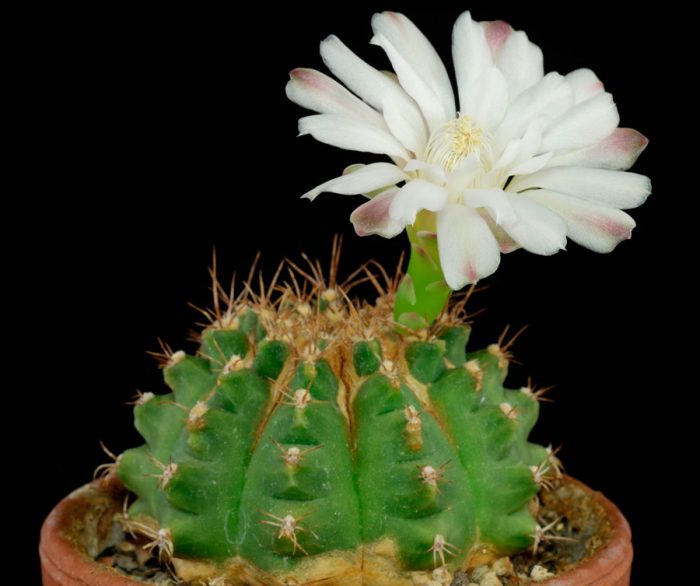
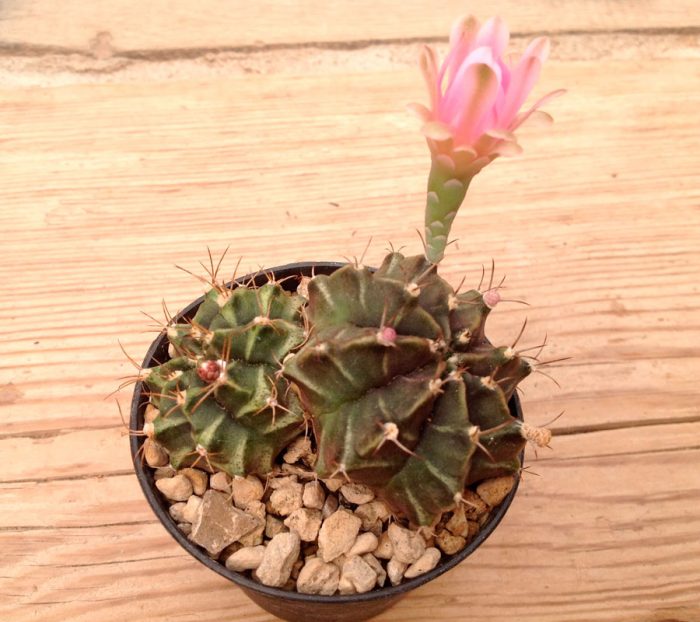
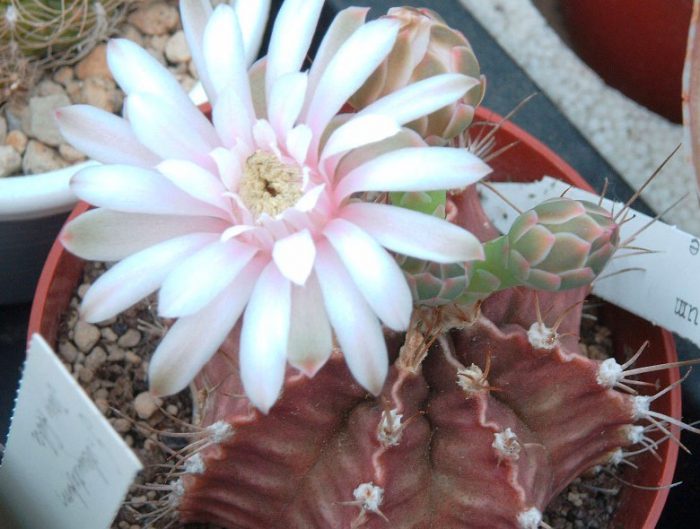
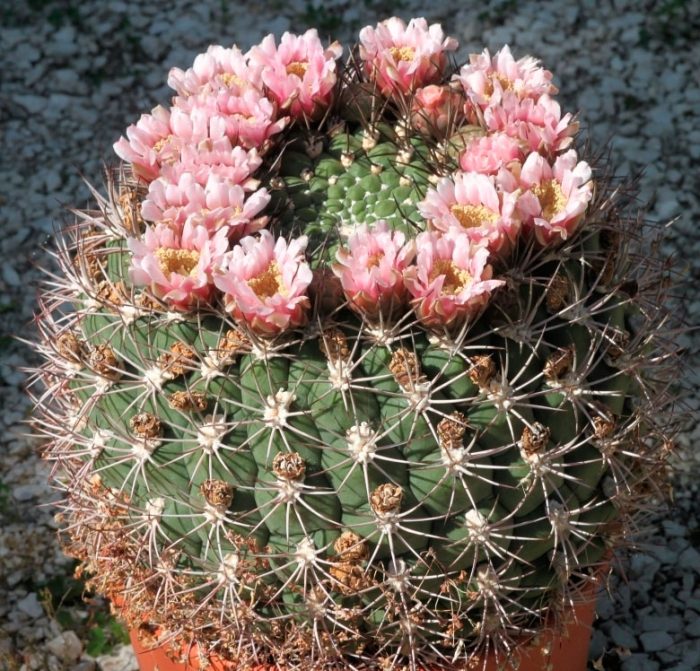
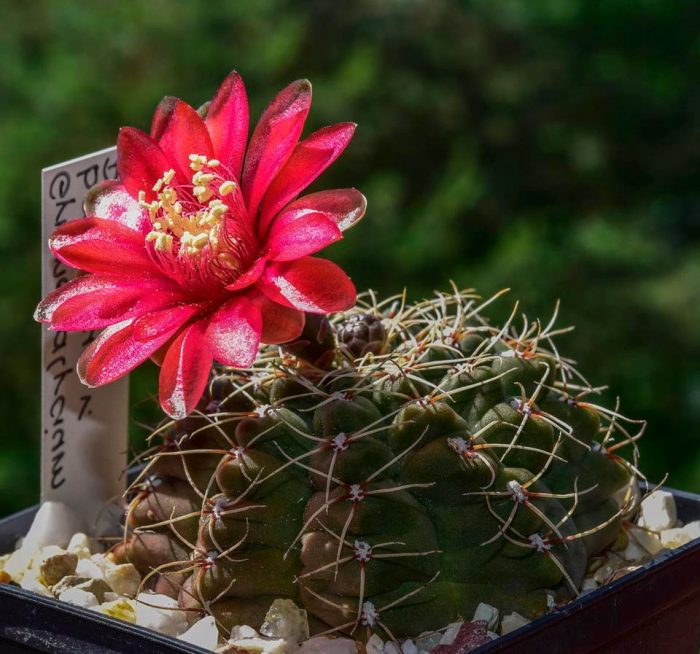
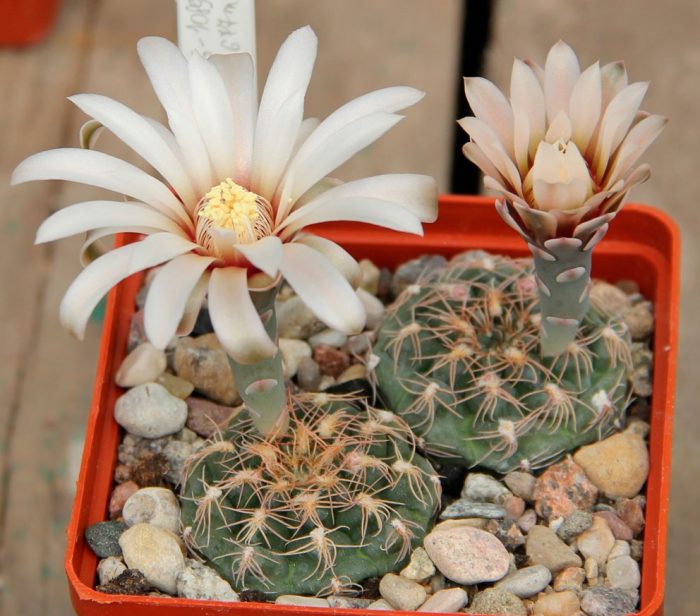
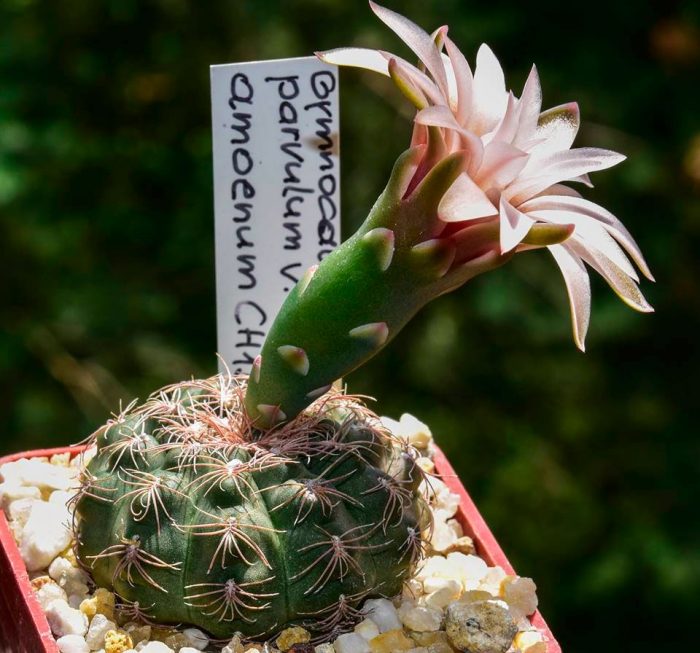
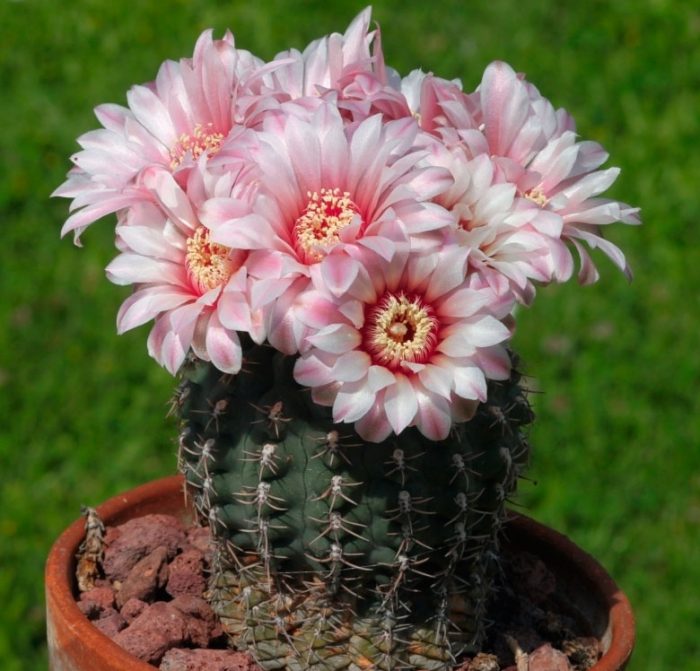
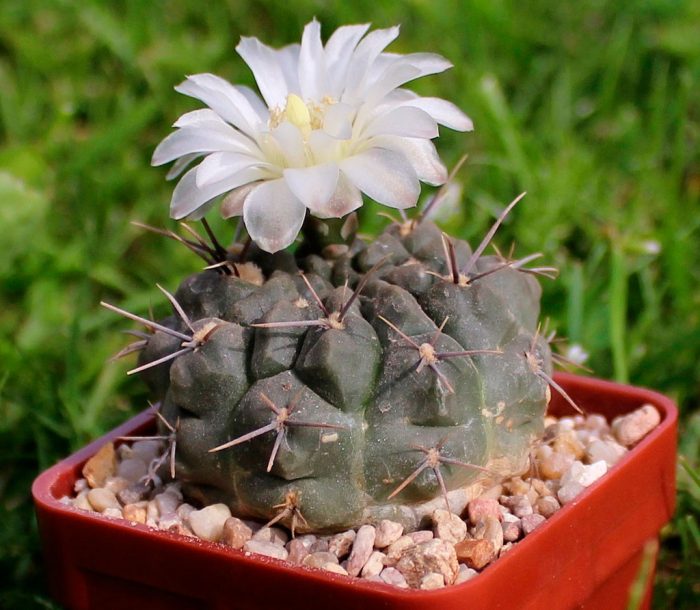



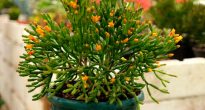
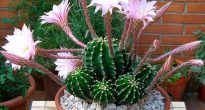
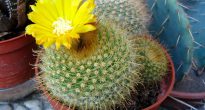
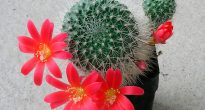
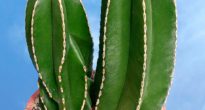
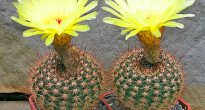

I really like the appearance of the hymnocalycium, it looks insanely beautiful, like some kind of hybrid of a cactus with an ordinary flower. It was quite easy to look after, the light, however, it was difficult to have a suitable amount of light, but then I found the nicest window sill.
Tell me what's wrong with my cactus, something brown underneath and never bloomed. I bought it in 2017. The picture cannot be inserted.